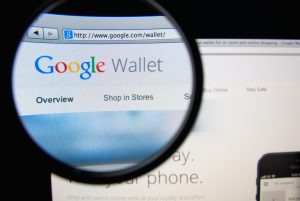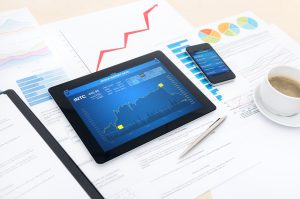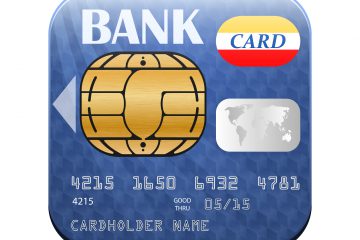Technology is changing the way people save, budget and spend their money. The internet and smartphones have given people the tools to easily keep on top of their finances, no matter where they are in the world. Here are some of the biggest ways that technology has changed our money management methods, as well as some future developments to watch out for.
Current Technology
Mobile

Google Wallet allows people to make payments via their smartphones by waving their phone in front of a payment terminal and deducting transactions from their linked bank account or credit card. With other mobile wallets, people can pay for bills and deposit checks without using cash or a credit card. By 2016, the use of credit and debit cards will start to decline.
E-coupons can also be downloaded from websites onto mobile devices. Then after scanning the phone, the coupons will be automatically applied.
Geo-location and QR codes
The combination of geo-location technology (which tracks your movements if you’re carrying a smartphone) and QR (Quick Response) codes (you can take a picture of your QR code via your smartphone camera) enable companies to provide personalised discounts and on-the-spot deals to customers who opt into their programs to increase customer loyalty. As a result, shoppers can get texts and emails that try to lure them into particular stores. The technology is also used to encourage customers to enter contests, look at new apps/products and contact customer service.
Online
E-commerce allows people to shop online instead of going to a physical store. Businesses are now competing with other businesses around the world, which is good for consumers, as they can find information that will help them make a more informed choice before making a purchase. Also, the more competition there is, the lower prices will be.
Social commerce (financial social networking) is used to identify the combination of commerce and social networking seen on social media sites such as Facebook, Twitter and LinkedIn. These sites make it easier for advertisements to reach customers without them looking out for a particular store.
With Weemba.com, people can search for a loan by posting details like why they need the money, such as debt consolidation, refinancing their mortgage or a kitchen makeover. Kickstarter.com allows people to provide money to those who need funds for their artistic endeavours. Bundle.com uses data tracking and spending information to create lists of famous restaurants and stores in a city, which helps people find the right place at the right price.
Alternative lending websites provide greater choice for borrowers without getting the bank involved. These online businesses often have competitive loan offerings with less stringent requirements that provide customers with better value for their money and more flexibility.
Person-to-person payments offered by American Express, MasterCard, Visa and PayPal allow customers to send and receive money online using links to their accounts and cards. Sending money anywhere in the world has never been easier, quicker and cheaper.
Online banking allows people to simply log into their bank’s online website and conduct their banking activities at home or anywhere else with an Internet connection. You can check your account balances, transfer money to another account and pay your bills. You can also link your accounts, open up a new account, buy or sell an investment, receive account alerts, set up a direct debit and keep track of your retirement savings. Banks and other money service sites also help people understand their finances by offering information in graphs or tables.
Web-based aggregation platforms help people manage their money by gathering all their financial information in one place, including their bank accounts from various banks, credit cards, savings, loans, mortgages, insurance, pension plans and employee benefits. With a single login, you can view how much money you have altogether. They also display pie charts indicating where your money was spent and if you went over your spending limits. You can pay and keep track of your bills, investments, and so on.
Some platforms enable you to set financial goals and track progress. If your account will be overdrawn, they can show you other options of borrowing money and how each one will affect your overall wealth. Aggregation platforms also have behavioural economics built into their design, which helps users understand the effects of their financial decisions.
Aggregation platforms include Planwise, LoveMoney.com, Money Dashboard, MoneySupermarket’s On Trees, YourWealth.co.uk’s MoneyHub and Aon’s Bigblue service. Some platforms have mobile apps, like Mint.com, Manilla.com and Check (formerly known as Pageonce).

Many online investment companies, such as Personal Capital, Jemstep and Betterment, are offering high-quality, personalised and low-cost investment advice to investors regarding wealth management. Investment platforms also offer a consolidated view of all your investments and personal finances in one place.
Electronic trading involves computers matching buyers with sellers and allows people to access the stock market. Anyone can access trading information as well as trade stocks for just a few dollars. As a result, the stock market now has a diverse mix of big financial institutions and individual traders.
Super funds enable people to go online and check their account balance, but not all of them. Banks have introduced simple and low-cost super accounts, which you can incorporate into your online and mobile banking. With a single login, you manage both your super and daily banking activities. With technology and mobile apps, people can take greater control of their super by rounding up all their super accounts into one account.
You can also keep track of how your super is being invested and if you don’t like it, you don’t have to change funds – you can just switch to another investment option or consider a life-stage fund that adjusts your investments automatically according to your savings goal. By 2017, 85% of super funds are expected to use mobile apps for online banking.
Future Technology
Wearables
Wearables such as smart watches and Google glass are already increasing in popularity. By 2019, wearable electronic devices will also be built into clothes, and will start to replace mobile phones as a means of making payments and accessing accounts.
Driver-monitoring
By 2023, all vehicles will most likely be automatically equipped with technology that monitors their driving behaviour, which will be used by insurers to determine what fees to charge clients. Car insurance will become more tailored as insurers use black boxes to also track your driving speed, braking and mileage to set premiums. In 10 years’ time, drivers will need to have tracking technology. So if you regularly brake suddenly or drive through an accident black spot, your premiums could be pushed up.
Eye-scanning
In 2024, it’s predicted there will be technology like glasses that can perform eye scans for early detection of disease, which could change the way people buy insurance. Instead of buying health insurance to insure yourself against possible illnesses, eye scans will detect health problems that you’ll most likely get in the future, such as diabetes, and then you may have to buy cover for those illnesses.
Thought-recognition
Investment firms and advisers are looking to have developed by 2025 digital thought-recognition systems that monitor biometric responses to information in order to check if clients understand the risks they’re taking. Thought-recognition technology is a software that can read your facial expressions and understand your emotional state, as well as measure how well you grasp complex financial products. Companies could use this technology to figure out when’s the best time for you to make a good financial decision before sending you information.
Many seemingly futuristic personal finance technologies will go mainstream in the not-so-distant future, which will have a big impact on the way people bank, shop and track their finances. Some services will be web-based, while others will take advantage of the increase in smartphone usage. Whether you’re trying to get on top of your finances or build wealth for the future, technology makes it easier to keep track of your money and make it grow, as well as provide you with the information you need to make sound financial decisions.




